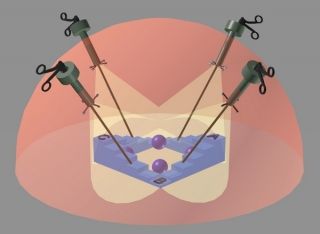Laparoscopic surgery has revolutionized surgical practice by allowing for minimally invasive procedures that reduce patient discomfort, shorten hospital stays, and accelerate recovery times. However, traditional laparoscopic imaging systems have limitations in terms of image quality, flexibility, and cost.
Wireless microcamera clusters are a new laparoscopic imaging technology that has the potential to overcome these limitations. In this essay, we will discuss wireless microcamera clusters and their potential for improving laparoscopic imaging.
Overview of Wireless Microcamera Clusters:
Wireless microcamera clusters are a new type of laparoscopic imaging technology that consists of multiple microcameras that are wirelessly connected to a computer. The microcameras are small and flexible, allowing them to be placed in various locations within the abdominal cavity to provide a more comprehensive view of the surgical site.
The microcameras are also capable of transmitting high-quality, real-time images to the computer, providing surgeons with a clear and detailed view of the surgical site. The wireless connectivity of the microcameras also allows for greater flexibility and maneuverability during the procedure, as surgeons can easily move and adjust the cameras as needed.
Advantages of Wireless Microcamera Clusters:
Wireless microcamera clusters offer several advantages over traditional laparoscopic imaging systems. Firstly, the use of multiple microcameras allows for a more comprehensive view of the surgical site, reducing the risk of missed lesions or injuries. This can improve patient outcomes by reducing the need for additional procedures or follow-up surgeries.
Secondly, the wireless connectivity of the microcameras allows for greater flexibility and maneuverability during the procedure. This can reduce the need for multiple incisions, as surgeons can easily adjust the cameras to obtain the best view of the surgical site. This can result in less patient discomfort, shorter recovery times, and lower healthcare costs.
Thirdly, the use of wireless microcamera clusters can also reduce the cost of laparoscopic imaging systems. Traditional laparoscopic imaging systems require expensive equipment and infrastructure, including light sources, cameras, and monitors. In contrast, wireless microcamera clusters require only a computer and wireless connectivity, making them a more cost-effective option.
Challenges of Wireless Microcamera Clusters:
Despite the potential advantages of wireless microcamera clusters, there are also several challenges associated with their use. Firstly, the quality of the images produced by microcameras may be lower than traditional laparoscopic imaging systems. This can make it difficult for surgeons to identify subtle details, such as tissue texture and depth.
Secondly, the use of multiple microcameras can increase the complexity of the procedure and the potential for technical difficulties. Surgeons must be trained in the use of wireless microcamera clusters and must be able to troubleshoot any technical issues that arise.
Thirdly, the wireless connectivity of the microcameras may also pose a security risk, as the transmission of data could be intercepted or hacked. To mitigate this risk, appropriate security measures must be put in place to ensure the privacy and security of patient data.
Conclusion:
Wireless microcamera clusters are a promising new laparoscopic imaging technology that has the potential to improve surgical outcomes, reduce patient discomfort, and lower healthcare costs. The use of multiple microcameras and wireless connectivity allows for a more comprehensive view of the surgical site and greater flexibility and maneuverability during the procedure.
However, the use of wireless microcamera clusters also presents several challenges, including potential technical difficulties, reduced image quality, and security risks. These challenges must be carefully considered and addressed before widespread adoption of wireless microcamera clusters in laparoscopic surgery.
Overall, wireless microcamera clusters represent a significant advancement in laparoscopic imaging technology and have the potential to improve surgical outcomes and reduce healthcare costs. Further research and development of wireless microcamera clusters are needed to address the current challenges and to fully realize their potential in laparoscopic surgery. Additionally, ongoing training and education for surgeons will be necessary to ensure the safe and effective use of wireless microcamera clusters.
One potential application of wireless microcamera clusters is in the field of robotic surgery. Robotic surgery allows for greater precision and control during surgical procedures, but requires high-quality imaging systems to guide the robot. Wireless microcamera clusters could provide the high-quality, real-time imaging necessary for robotic surgery, potentially improving patient outcomes and reducing healthcare costs.
Another potential application of wireless microcamera clusters is in the field of telemedicine. Telemedicine allows for remote consultations and surgeries, but relies on high-quality imaging systems to provide surgeons with a clear view of the surgical site. Wireless microcamera clusters could provide the necessary imaging for remote surgeries, potentially expanding access to surgical care for patients in rural or underserved areas.
In conclusion, wireless microcamera clusters are a promising new technology in laparoscopic surgery that has the potential to improve patient outcomes and reduce healthcare costs. While there are challenges associated with their use, ongoing research, development, and training can help overcome these challenges and allow for the safe and effective use of wireless microcamera clusters in laparoscopic surgery. As technology continues to evolve, it is likely that wireless microcamera clusters will play an increasingly important role in the future of surgical imaging.


